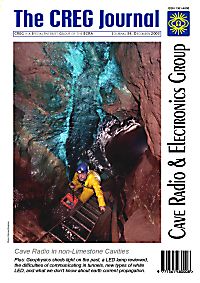
- The most recent issue to be published was 125
- For further information, please see Publishing/Despatch Schedule
- Database last updated on Wed, 03 Apr 2024 16:35:02 +0100
- Online access is currently available for all issues. Some of
the older issues are bit-map scans rather than digital copies.
journal scans.
- Online voting for CREG articles was withdrawn in June 2022. For info see
Voting for CREG articles
Contents of journal 54
December 2003
This page may take a few
seconds to load. Please wait ...
- CREG Journal
(PDF 11.1MB)
  Individual articles may be available below Individual articles may be available below
- Contents
-
- Newssheet
- Data-logging, Digital Photography & Cave Radio in Snowdonia, Colour Cover, CREG AGM Minutes, Volunteers Wanted.
-
- Communication in Standedge Tunnel
- CREG members have been asked whether they could provide communication in railway tunnels for use by the emergency services in the case of an incident. The Standedge Tunnel under the Pennines has proved particularly difficult. Mike Bedford looks at the problems and some potential solutions for tunnels in general.
-
- Cave Radio Interference from LED Lamps
- Mike Bedford reports that the new generation of caving lamps based on white LEDs can cause interference to cave radios.
-
- Speleonics
- With cave radios well established for rescue purposes, people are wondering what else they might be useful for. John Rabson summarises some of contributions to the discussion.
-
- Equipment Review: The Nova Caving Lamp
- The Nova, from Speleo Technics, is the first commercially available caving lamp to use the Luxeon 5W single-chip LED. David Gibson describes how the lamp fared underground and offers some thoughts on how the design could be enhanced. See also www.speleogroup.org/attinya.html.
-
- How to Design an Electronic Surveying Instrument
- Martin Melzer's aim is to replace mechanical sighting instruments and tape measure with an electronic instrument that is easier to operate and at least as accurate. In this article he describes the problems of accuracy and calibration and suggests a future course of development. .
-
- A Mud Bath for the HeyPhone
- A rescue in Otter Hole proved a severe test for the HeyPhone. Pete Allwright describes how it survived the mud and provided effective communication. Advice is given on using the HeyPhone in these conditions.
-
- Chairman's Report 2002/2003
- Chairman Richard Rushton outlines CREG's achievements during the last year and assesses the challenges which lie ahead.
-
- 4-page INSERT:
- Corrections to articles in Journal 52 & 53.
-
- WebWatch
- Information on the Web, courtesy of Peter Ludwig.
-
- Treasurer's Report 2002/2003
- Treasurer Rob Gill presents a summary of CREG's accounts and reports on the group's financial status during the last financial year.
-
- CREG Award 2003
- Stuart France was presented with the CREG award for 2003. Here Rosy Rabson looks at the man behind the award.
-
- Geology & Conductivity: Exploring the Relationship
- withPerformance of cave radios is affected by the electrical conductivity of the ground. Here Mike Bedford looks at the way in which the conductivity is influenced by rock type.
-
- Geophysics in Cave Archaeology
- Although the jury's still out on the worth of geophysics for finding new caves it is reaping benefits in cave archaeology. Rhianwen Jenkins and Mike Bedford describe how seismic surveying was used to plan an archaeological dig in Cooper's Hole and how ground-penetrating radar was employed in Peak Cavern. .
-
- What We Don't Know About Earth-Current Propagation
- The propagation of electromagnetic signals from an earth-current antenna, such as the HeyPhone uses, is difficult to model, and there are several questions that have not been adequately answered. David Gibson explains the problems.
-
- Letters to the Editor
- Letters.
-
- The Future is not Pale Blue, but Many Shades of White
- Most of today's white LEDs are, in fact, blue LEDs with a yellow phosphor. But totally different types of white LED are being developed and may offer advantages, including a warmer shade of white. Mike Bedford assesses the technologies.
-
- We Hear
- A round-up of news, collected by John Rabson.
-
- How to Take 3D Digital Photographs Underground
- Mike Bedford outlines the procedure for taking stereo photographs using a digital camera. An example of a full-colour stereo anaglyph is given on the back cover.
-

|

View Contents:

BCRA is a UK registered charity and is a constituent body of
the British Caving Association,
undertaking charitable activities on behalf of the BCA.
BCRA publishes a range of periodicals and books.
Click here for further information.
|
Searching
To Search our pages using Google, type a search
string in the box at the top of the page and hit your Return key
You can also search our publications catalogue at the British Caving Library
The CREG Journal Search Engine is a new, powerful search engine which will, sometime, be extended
to cover Cave & Karst Science. We have a keyword search facility on our Cave Science Indexes pages but this may be rather out-of-date.
|
For staff use: Link to Database
Show/Hide
download figures next to each item (if available and non-zero; you might need to refresh page first). Counters last
reset on Thu 03-Jan-2019 17:29:28 +00:00. The figures are non-unique
click-throughs.
|








